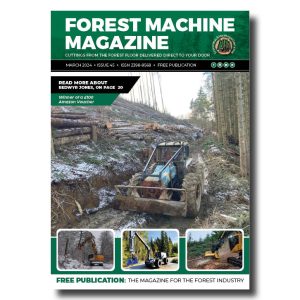Climate change-induced wildfires, floods, heatwaves and pest outbreaks could wipe out up to €247 billion in standing timber by 2100—double today’s €115 billion estimate—unless managers completely re-examine decades-old forest practices, new research in Nature warns.
The study “The Rising Cost of Disturbances for Forestry in Europe under Climate Change,” led by Johannes S. Mohr at the Technical University of Munich, finds that under a high-emissions pathway (RCP8.5), Europe’s forestry industry could see its gross value added collapse by as much as 15%.

-
That’s a remarkable amount of work hours for a single machine, the Norcar 600 owned by Erkki Rinne is taken well care of, it even has the original Diesel engine.
-
Kieran Anders is a forestry contractor working in the lake district. His work involves hand cutting and extracting timber using a skidder and tractor-trailer forwarder.
-
It is not possible to eliminate chain shot, but there are simple steps that can be taken to reduce the risk.
-
Arwel takes great pride in the fact that the mill has no waste whatsoever, “the peelings are used for children’s playgrounds, gardens and for farm animals in barns in the winter and the sawdust has multiple uses in gardens and farms as well.
-
Timber hauliers need to encourage young blood in, and also look after the hauliers we have, we need make the sector a safe and positive place to work.
FIND US ON
Related Posts
“Central Europe emerges as a continental hotspot of disturbance costs, with projected future losses of up to €19 885 per hectare,” Mohr said, flagging that storms, bark-beetle outbreaks and extreme weather will inflict the heaviest damage there. By contrast, warming-driven growth spurts in Northern Europe’s boreal forests may partly soften the financial blow.
Over the past 20 years, disturbance rates have more than doubled across the continent, triggering tree-mortality events unseen in at least 170 years. Yet many forest plans still favour even-aged conifer plantations—systems that maximise yield under stable conditions but expose landowners to crippling losses when disaster strikes. “Ignoring disturbance risk leaves conventional, yield-driven strategies vulnerable to massive financial and ecological losses,” the paper warns.
Southern Europe faces the bleakest outlook. Already home to the continent’s lowest timber values, it stands to suffer further declines as drought and wildfire threats escalate. The authors stress that while productivity gains may cushion forests in Northern and parts of Central Europe, they will not materialise in the south.
To curb economic damage and build resilience, the study urges three key silviculture reforms:
– Diversify species mixes so no single disturbance agent can decimate large stands
– Shorten rotation lengths by as little as five years—field trials show this can cut disturbance-related losses by 10–20%
– Establish mixed-species plantations that pair fast-growing varieties with more resilient trees
However, the authors caution that these measures carry trade-offs for carbon storage, biodiversity and habitat value, and must be tailored to each region. Critically, only under a low-warming scenario (RCP2.6), which limits end-century temperature rise to about 1.5 °C, do productivity gains outweigh escalating disturbance costs across all of Europe. “Mitigating climate change can avoid substantial disturbance-related costs in the forestry sector,” Mohr said, adding that in a high-emissions future, severe losses—particularly in Central and Southern Europe—are all but certain.
Source: nature.com

Sign up for our free monthly newsletter here
Contact forestmachinemagazine@mail.com to get your products and services seen on the world’s largest professional forestry online news network.
#homeoflogging #writtenbyloggersforloggers #loggingallovertheworld
Written by loggers for loggers and dedicated solely to the equipment used in forestry operations.







